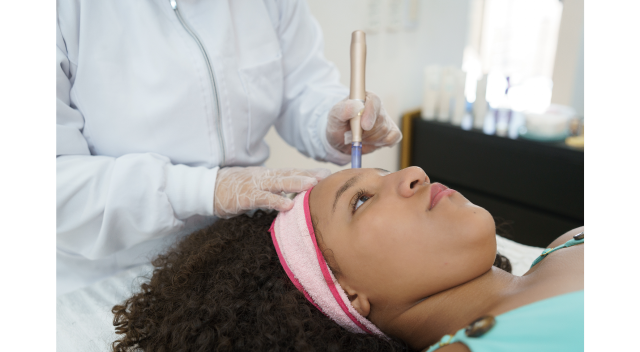What’s Microneedling Good For? All You Need To Know

Manager
Published on Apr 16, 2024

In today’s world of sharing visual experiences on social media platforms like Instagram, you’ve probably come across microneedling, a minimally invasive procedure that utilizes tiny needles to pierce the skin and improve its appearance. But what’s microneedling good for and how does it work? This post breaks down everything you need to know about this transformative procedure. So let’s get started.
What is microneedling?
Microneedling, also known as collagen induction therapy, is a cosmetic procedure where the skin is punctured with small, sterilized needles. These tiny wounds prompt the body to produce more collagen and elastin, leading to skin healing and a more youthful appearance. Numerous studies have proven the effectiveness of microneedling. Furthermore, a randomized controlled trial in 2020 also evaluated the safety and efficacy of microneedling in combination with PRP, a type of regenerative therapy that utilizes and enhances the natural growth factors present in our blood cells. It's believed to accelerate the healing process as well.
So, what is microneedling good for?
Microneedling is a versatile cosmetic treatment that can help diminish the size of pores and improve the quality and texture of the skin. At Gilded Leaf, we recommend microneedling to help reduce fine lines and wrinkles and improve the appearance of stretch marks, hyperpigmentation, mild scars and acne scars.
What about side effects?
When performed correctly, the risks associated with microneedling are generally minimal. You might notice some temporary redness and tenderness for a few days post-treatment, but these side effects usually resolve on their own. It's crucial, particularly for in-office sessions, to seek treatment from a well-trained, licensed technician with ample experience to minimize any potential complications.
Infection can occur if the provider applies too much pressure with the needles, resulting in larger wounds than intended, or if an at-home microneedling device isn't adequately sanitized.
While microneedling is safe for most people, we advise against microneedling for individuals with highly sensitive skin, as it could potentially lead to irritation. Additionally, it's best to refrain from performing this treatment or using derma rollers at home if you have inflamed skin, cystic acne, or active breakouts to prevent exacerbating any existing damage.
What’s the recovery like?
Recovery after microneedling is pretty straightforward, especially if you undergo the procedure at Gilded Leaf, where you'll receive detailed aftercare instructions. The micro-wounds created during the treatment typically heal relatively quickly, although visible results may take a few weeks to manifest. We suggest applying a serum containing hyaluronic acid, growth factors, or peptides afterward to facilitate the absorption of active ingredients into the skin, targeting your specific concerns. It's also essential to use sunscreen to protect your skin from sun damage.
To prevent irritation, avoid applying makeup on newly microneedled skin and refrain from using products like retinol, alpha- and beta-hydroxy acids until your skin has fully healed. Additionally, during the recovery period, it’s best to avoid intense workouts or other activities, that could cause excessive sweating.
Can I do microneedling myself at home?
Sure, you can. There are microneedling devices on the market that over time can brighten and tighten the skin. However, they’re not as effective as in-office procedures because the needles don’t penetrate the skin as deeply and it can take months before you see results. That said, DIY microneedling can be beneficial for milder concerns and can supplement in-office treatments.
Does it work?
We’ve answered the question “What’s microneedling good for?” but does it really work and is it safe?
When microneedling is used for the right reasons and done by experienced esthetic providers, it can make a significant difference. However, it's not a quick fix. Clients usually need several sessions, and sometimes at Gilded Leaf, we pair it with other treatments to get the best results, especially for things like acne scars and stretch marks.
Microneedling is safe for all types of skin
Feeling uneasy about a pen-like device puncturing your skin is normal, but don't worry. It only penetrates the outer layer, the dermis, and the punctures are tiny—barely noticeable. They don't go deep enough to cause scarring.
Because of this, microneedling is considered safe and effective for all skin types. When done correctly, microneedling is a safe, straightforward, and efficient method for achieving gorgeous skin and there’s hardly any downtime required.
Does microneedling hurt?
One of the first questions we’re asked about microneedling is does it hurt. It may cause some discomfort, but does it hurt? Well, not so much.
To minimize any potential discomfort during your treatment, we always administer a topical numbing cream before we start.
Although you might still feel pressure or a sensation similar to scratching during the procedure, actual discomfort is unlikely.
If you do feel any discomfort during microneedling, it's usually more noticeable in areas with less flesh, like your jawline, forehead, and hairline.
To reduce the chance of discomfort, it's best to avoid using any skincare products that might irritate your skin, such as retinol or other exfoliants, before your treatment.
If you usually shave or microblade your face, it's a good idea to stop a few days before your appointment.
How many treatments will be needed?
How many microneedling sessions you need varies based on the area being treated. We typically suggest starting with a series of two to three treatments spaced out every four weeks. Our goal is to help you achieve the skin you're happy with and then maintain it.
How much does it cost?
We recommend you schedule a consultation with Gilded Leaf, where you can chat with one of our providers who will determine the appropriate treatments required to achieve your skin goals and discuss the associated costs.












.jpg&w=750&q=75)